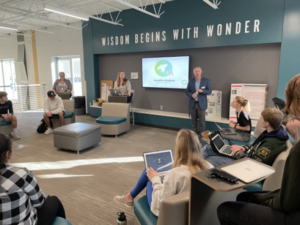Blended Learning: What Research Says
 Kaplan recently released a review of Online and Blended Learning: What the Research Says. Author Marcella Bullmaster-Day, Ed. D. is the Associate Director of the Lander Center for Educational Research at Touro College and is a Kaplan advisor. It’s well researched and worth a read. I bet Chief Academic Officer and super-smart learning scientist Bror Saxberg made a few helpful hints.
Kaplan recently released a review of Online and Blended Learning: What the Research Says. Author Marcella Bullmaster-Day, Ed. D. is the Associate Director of the Lander Center for Educational Research at Touro College and is a Kaplan advisor. It’s well researched and worth a read. I bet Chief Academic Officer and super-smart learning scientist Bror Saxberg made a few helpful hints.
The paper suggests that online and/or blended-learning courses usually include some mix of three kinds of instruction:
- expository instruction (direct presentation of material through lecture, text, visuals, animation);
- active learning (the individual student researches information, solves problems, takes quizzes, manipulates digital artifacts, engages in drills, simulations, or games); and
- interactive learning (students collaborate with other students).
Here’s the conclusion: effective online and/or blended learning:
- Is personalized and adaptive to meet individual learning needs.
- Supports high levels of cognitive engagement in meeting learning objectives.
- Balances computer- or teacher-led guidance with learner control.
In the section on personalization, Marcella notes that:
Regular monitoring of each student’s progress provides data to: guide differentiated instruction; offer students constructive immediate feedback and guidance as to how to improve; and group students for further instruction and practice.
On cognitive engagement, she recommends :
Lesson material is segmented into manageable chunks and students are allowed to sufficiently process it through practice, which may involve collaborating with other students. Practice is most effective when it: is relevant to the learning goal; is spaced or distributed over time; mixes different types of problems; requires effortful retrieval, not merely recognition, of new knowledge and skills; and includes tailored explanatory feedback.
On balancing student versus instructor controls:
When students have some control over the sequence of lessons or topics within lessons; the amount of time they spend on each lesson; and their access to learning supports like practice exercises or worked examples, learning is enhanced.
Blended learning strategies have been used extensively for more than a decade in corporate and military training. As education shifts to job training it becomes increasingly productive to back map learning experiences from specific job requirements. Bror notes (in a recent blog) that there’s quite a lot of research, done mostly by cognitive psychologists, not folks within domains, showing how to improve the outcomes for learners:
- There’s both research and practice in a wide, but scattered, array of domains showing how to more carefully extract and document what the best experts in many field do when they make decisions in their domain. (Cognitive task analysis – note that you need a way to objectively determine expertise in a field to make these techniques really sing, so not every academic discipline is likely to benefit. ) Much of the decision-making turns out to be unconscious, so careful interviewing is key – and, again, it’s not a hobby activity, it takes time and practice to become good at this.
- Even with a better layout of what experts are doing, you still need to carefully architect a sequence of experiences for a mind to build up conscious and sub-conscious capacities to act in that way. There is, again, a body of knowledge about that (see, for example, E-Learning and the Science of Instruction), but again, applying this well is not exactly a hobby – requires time, information, and coaching to get good at this.
It’s interesting to note that Kaplan, the higher ed and test prep giant, sold their online high schools (shortly after buying Insight) to K12 in May. Kaplan K12 Learning Services (www.kaplank12.com) sells tutoring and test prep services to K-12 schools.
It’s also interesting that in 2011—the year of the blended inflection—we’ve seen an interesting confluence of 1) edtech products, particularly adaptive math, 2) tabs and apps, 3) expanded access to online courses and instruction, and 4) a lot of smart lessons from test prep and SES providers like Kaplan.
For more from Bro see his popular blog on game-based learning, SKYRIM: How far r uu?






Craig
We've been cognitively engaging students in music in this manner for decades.